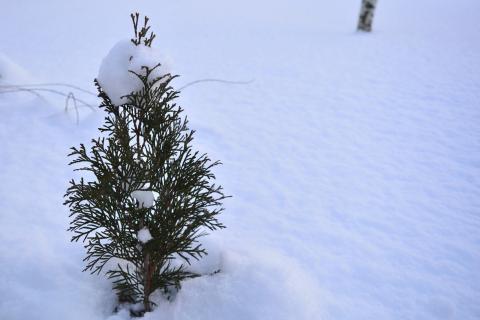Do My New Evergreen Shrubs Need Winter Protection?

Severe winter weather in New Hampshire often damages evergreen plants in the landscape, particularly those that have been recently planted. Brown, burned leaves and needles are a common occurrence in the late winter months and spring. Fortunately, there are a number of practices you can employ right now to help keep your evergreens healthy.
Winter Water Loss
Because they do not shed their leaves, evergreens lose water over the winter in a process called transpiration. Water loss is greatest during periods of strong winds and mild sunny weather. During periods of super cold weather, the ground freezes and cuts off water to the plant’s roots. Under these conditions water is transpired faster than it is taken up, and the leaves can begin to dry out and turn brown.
Winter Protection
Using Burlap or Canvas to Protect Your Plants from Prevailing Winds
Winter damage can be mitigated by creating wind breaks made from burlap or canvas. Attach the material to frames built on the side of the plant facing prevailing winds. Another option is to wrap burlap around the entire plant which works especially well for compact plants such as arborvitae. Never use black plastic as it causes extreme temperature fluctuations.
Using Mulch to Protect the Root Zone
Freezing and thawing can heave newly planted trees and shrubs from the ground, causing damage to their root systems. Applying two inches of woodchips or straw over the root zone will insulate the soil and protect the root. Just take care not to pile mulch against the plants’ trunks, as this can encourage insect, disease, and rodent issues.
Using Wooden Frames to Protect Evergreens from Heavy Snow Damage
Evergreens are also at risk of breakage from heavy snow and ice loads. Trees and shrubs which are planted near the eaves of buildings often end up with broken limbs from plummeting snow loads. Placing wooden frames over plants can keep them from getting crushed. It is also a good idea to brush off heavy snow with a broom if it is causing limbs to bend excessively.
Protecting Evergreens from Nuisance Wildlife
Wildlife may also pose a significant threat to many evergreens in the winter months. When food is scarce, voles will strip the bark from some plants such as Russian cypress and juniper, and white-tailed deer will often browse heavily on arborvitae and yew. Placing guards around the bases of young trees and shrubs will help limit vole damage, just as installing fences around susceptible plants will protect against deer. If fencing isn’t an option, repellants can offer some defense provided they are reapplied multiple times throughout the season.
Got questions? The Ask UNH Extension Infoline offers practical help finding answers for your home, yard, and garden questions. Call toll free at 1-877-398-4769, Monday to Friday, 9 a.m. to 2 p.m., or e-mail us at answers@unh.edu.
Related Resource(s)
Do you love learning about stuff like this?
SUBSCRIBE TO Granite State Gardening newsletter
Got questions? The UNH Extension Yard and Garden Infoline offers practical help finding answers for your yard and garden questions.
Call toll free at 1-877-398-4769, Monday to Friday, 9 a.m. to 2 p.m., or fill out webform.
